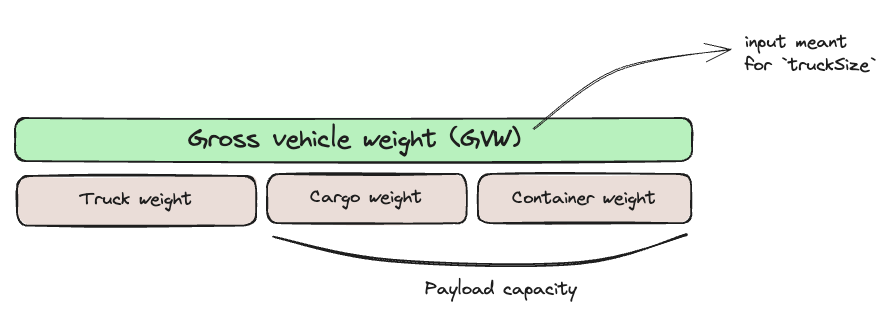Choosing the right truck size is key to estimating emissions accurately. This guide helps you understand how truck weights, shipment types, and regional practices affect your CO₂ calculations. Whether you know the exact truck configuration or not, you'll find clear guidance to make informed, GLEC-compliant assumptions.
📖 Weight definitions

Gross vehicle weight (GVW)
The total weight of the truck, including the truck itself, the container, and the cargo.
The truckSize input in our API refers to this gross vehicle weight.
Road regulations typically cap this at 35-40 tons to ensure safety and infrastructure protection. However, this limit can vary by region:
- Europe: standard GVW is ~40t, with some allowances up to 44–50t.
- North America: federal limit is ~36t (80,000 lbs), with exceptions up to 74t for special axle setups.
Payload capacity
The maximum weight a truck can legally carry, including the cargo and the container.
- A 20-foot container's (20GP) has a tare weight (empty weight) of ~2.2t.
- A truck with a 15–20t payload capacity can carry 12.8–17.8t of cargo, depending on the container weight.
Truck weight (curb weight)
The weight of the truck when empty, including the chassis and any attached trailer.
- Typically ranges from 7 to 10 tons, depending on configuration and region
⚙️ Specifying truckSize in your request
truckSize in your requestThe truckSize field is applicable in the following APIs:
- Shipment API:
/shipment/v2/report/co2
When providing truckSize, specify the GVW. Based on this weight, we will assign the appropriate truck size.
- Accepted GVW range: 0 - 72t.
- If no
truckSizeis provided, we use the smallest truck size available, as follows:- For
parcelshipments, we use the smallest available truck that can carry the shipmentweight. - For
FCLandLCL(containerized) shipments, we assume a minimum of 26t, which matches the smallest capacity capable of carrying containers.
- For
Bigger the truck, lower the emissionsAccording to the *GLEC Framework, larger trucks generally emit less CO₂ per ton-kilometer due to improved fuel efficiency per transported unit of cargo.
📐 Methodology for calculating road transport emissions
🔍 Parameters that matter
We apply road transport emission factors based on the following key parameters:
- Shipment type (
FCL,LCL,parcel)
→ Including whether the container is dry or refrigerated - Region
→ Europe, North America, South America, Asia, Oceania, or Africa. - Truck size
→ Given as GVW (gross vehicle weight) in metric tons.
Each combination determines the emission factor applied, in accordance with the GLEC Framework v3.1.
🚚 Truck size parameter
The list below shows how GLEC splits truck sizes by GVW (valid for all regions but North America):
- <3.5t (light commercial vehicles/vans)
- 3.5–7.5t (light trucks)
- 12–20t (medium trucks)
- 20–26t (upper medium trucks)
- 26–32t (heavy trucks)
- 32–34t (upper heavy trucks)
- 34–40t (large heavy trucks)
- 40–44t (maximum for most road networks)
- 44–60t (modular combinations - specific countries)
- 60–72t (high-capacity vehicles - Nordic countries only)
In North America, truck size classification is simplified under the SmartWay program:
- <3.5t (van)
- > 3.5t (general truck - straight truck or tractor-trailer)
Notes:
- No need to memorize or match these manually. This is simply to explain how emission factors vary behind the scenes, based on the
truckSizeinput. Just provide the GVW, and we’ll take care of assigning it to the correct category and applying the right emission factor. - The categories shown (e.g. vans, heavy trucks) are not labels given by GLEC, but references to help you relate GVW ranges to typical market truck types.
💡 Recommended assumptions by region and logistics operations
Understanding which trucks are typically used in different regions helps align emissions calculations with real-life logistics practices. The table below gives an overview of common truck types, their typical gross vehicle weight (GVW), and primary use cases per region.
If the truck size isn’t known, you can use the tables below to apply realistic defaults, as long as it reasonably matches your logistics operations.
🚛 Containerized shipments
Use this when transporting full containers (FCL) or consolidated cargo (LCL).
| Region | Recommended GVW (t) | Notes |
|---|---|---|
| Europe | 40 (range: 33–44) | Standard for articulated trucks; 44t used where permitted |
| North America | 36 (range: 33–40) | Typical 5-axle tractor-trailer (80,000 lbs federal limit) |
| Asia | 33 (range: 30–40) | Often capped by road conditions; widely used for container trucks |
| South America | Range 33–40 | Varies by country |
| Africa | 33 (range 30–36) | Infrastructure varies; 33t is a safe, realistic assumption |
📦 Parcel shipments
🚚 Regional / local distribution
Use this for B2B, FMCG, or short-haul distribution within a region.
| Region | Recommended GVW (t) | Notes |
|---|---|---|
| Europe | 12–26 | Rigid trucks dominate regional and food/beverage deliveries |
| North America | 15–20 | Straight trucks (box trucks) widely used for local freight |
| Asia | 7.5–20 | Medium rigid trucks are common for intercity and peri-urban freight |
| South America | 20–30 | Medium-to-heavy trucks used for agricultural and general freight |
| Africa | 10–20 | Medium rigid trucks used in structured distribution |
🚐 Last mile / courier / very local delivery
Use this for e-commerce and lightweight deliveries in urban areas.
| Region | Recommended GVW (t) | Notes |
|---|---|---|
| Europe | 3.5 | Light commercial vans (<3.5t) dominate city delivery |
| North America | 4.5 | Class 2–3 vans used by Amazon, FedEx, etc. |
| Asia | 3.5–5 | Light trucks, mini-trucks, or even scooters |
| South America | 3–5 | Small vans and pickups are typical for city logistics |
| Africa | 3–5 | Informal trade, pickups, and light vehicles dominate |